Mössbauer spectroscopy
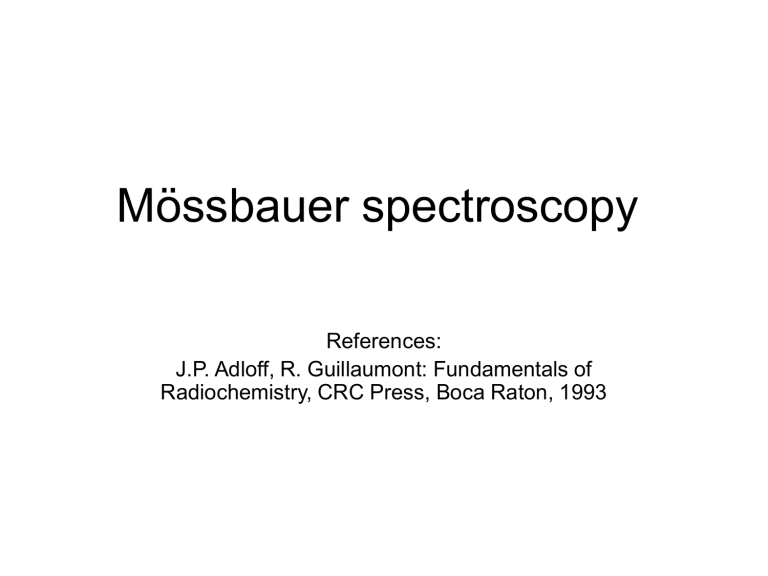
Mössbauer spectroscopy
References:
J.P. Adloff, R. Guillaumont: Fundamentals of
Radiochemistry, CRC Press, Boca Raton, 1993
Mössbauer effect: recoil free nuclear resonance absorption of g radiation
1,2
Recoil
Recoil
Recoil
EMISSION
E
2
E
1
E photon=(E
2
-E
1
)-R
E photon
E
ABSORPTION
E photon
E
1
E photon=(E2-E1)+R
0
-4 1
Energy
Line width (W) results from: natural width of E
2 level + Doppler widening due to temp.
W ~10 -6 eV (natural width) + 10 -3 eV (temp. effect) → 10 -3 eV (overall effect)
R~100 eV in nuclear processes, R’~10 -7 eV in optical processes
Realization of nuclear resonance:
Source and absorber contain the same element
(same nuclear energy levels).
Reduction of R by embedding the isotope in a solid crystal matrix, cooling the sample (reduced oscillation of the atoms, reduced R ↔reduced W).
The missing part of „2R” energy can be provided by moving the source due to Doppler effect
5/2- 137 keV
9% 91%
57
Co
10
-9
sec
271 days resonance absorption
3/2 14,4 keV 10
-7
sec
1/2- ground
57
Fe emitter
57
Fe absorber
Mössbauer spectrometer:
Source or absorber is moved. (Emission and absorption spectroscopy, respectively.)
Source or absorber should be in ground state, non-magnetic, symmetric environment precluding hyperfine splitting of nuclear level.
S g v
A D
S source emitting weak g radiation
A absorber moving with velocity v (mm/s)
D g radiation detector
The linear motion represents about 10 -8 eV.
The resulting Es energy is derived from the E g source energy:
Es= E g
(1
±v/c)
-10
The Mössbauer spectrum
Resonance absorption spectrum : g radiation intensity vs. velocity
(Energy)
0
0
10
Typical Mössbauer emission spectrum as the superposition of 2 single lines according to magnetic splitting of the nuclear levels in magnetic field:
237
Np
5/2-
5/2+ chemical shift
-1,2 velocíty (mm/s); energy (10 -7
eV)
-10
1,2
Typical Mössbauer emission spectrum as the superposition of 5 single lines according to quadrupole splitting of the nuclear levels in electric field:
237
Np
5/2-
5/2+
0
0
10 20
-1,2 velocíty (mm/s); energy (10-7 eV)
30
Chemical information in Mössbauer spectra
Spectra reveal splittings of nuclear levels, determined by the electronic environment.
• Isomer shift: position of the centroid of the line, oxidation state, covalency of the bondings
• Quadrupole splitting: multiplets asymetry in the electronic environment, chemical spin state, intensity of ligand field
• Magnetic splitting: multiplet due to magnetic field
Mössbauer active atoms
• 75 transitions in isotopes of 44 elements
• Radionuclide: MBq activity alpha, beta, EC or IT
T1/2: hours-hundreds of years
• Conditions to be fulfilled:
- E g
<100 keV,
- emitter should be bound in a lattice
- mean life-time of excited level: 1 ns-100 ns
- solid, cooled absorber (liquid N
2
), m>100mg
E.g.: 57 Co(EC) 57 Fe: 14,4 keV
241 Am(alpha) 237 Np: 60 keV
Tc, Th, Pa, U, Np, Pu, Am
Application examples
• Analysis of steels: oxidation state of iron (+2 or +3) chemical form (oxide, sulfate…) magnetic properties
• Analysis of iron oxide layers magnetite, hematite
• Recoil processes in condensed material
• Oxidation states of Np, Am compounds
Other nuclear related methods providing information on chemical environment
• Positron annihilation spectrometry
• Muon spectrometry
• Nuclear magnetic resonance
• Electron spectroscopies: photoelectron spectroscopy conversion electron spectroscopy
Auger electron spectroscopy
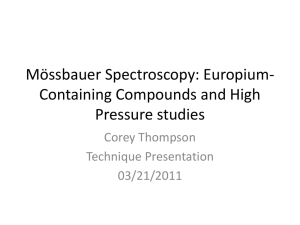
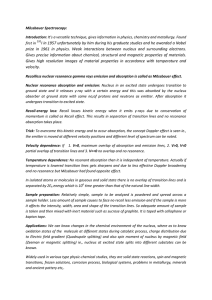

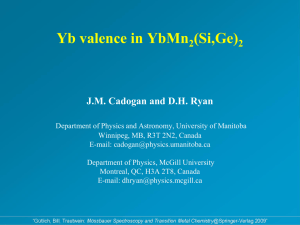

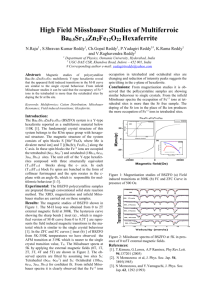



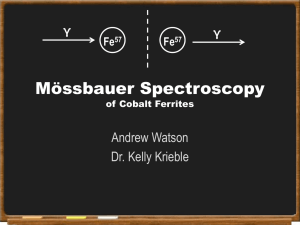

![The Politics of Protest [week 3]](http://s2.studylib.net/store/data/005229111_1-9491ac8e8d24cc184a2c9020ba192c97-300x300.png)